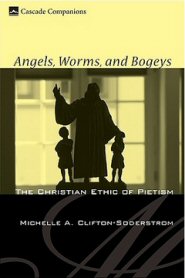
That’s basically the question my friend and Bethel University professor Chris Gehrz (better known as The Pietist Schoolman) raises and answers in his recent blog post.
Gehrz’s post focuses on two books — Douglas Shantz’s An Introduction to German Pietism: Protestant Renewal at the Dawn of Modern Europe and Michelle Clifton-Soderstrom’s Angels, Worms, and Bogeys: The Christian Ethic of Pietism. Chris has reviewed both in recent months. (His review of Clifton-Soderstrom appears in the August 2013 issue of Brethren in Christ History and Life.) Based on his consideration of both of these self-proclaimed “introductions” to a crucial movement within seventeenth-century European Pietism, Chris concludes that “the strengths of each largely mirror the limitations of the other.”
Here’s a preview of Chris’s post:
Shantz’s is not only double the price of Clifton-Soderstrom’s, but more than double the length. (And that not counting the appendices, bibliographies, and endnotes — more in a moment.) I concluded that its length “leave[s] the book rather more expensive than necessary for some of the undergraduate and seminary students and ‘others interested in learning about a defining moment in the Christian story’ that make up Shantz’s intended audience.” Though Shantz has his moments as a writer, it is too rarely the “lively” read promised on the back cover, while I praised Clifton-Soderstrom for “[writing] in a style that is concise… and eminently readable.” In short, Angels, Worms, and Bogeys’ “accessible writing, clever structure, and practical bent make it a valuable addition to the Cascade Companions series, which seeks to acquaint non-specialists with the Christian theological tradition.”
While Clifton-Soderstrom’s sketches of her three central figures — Philipp Jakob Spener, Johanna Eleonora Petersen — were more consistently interesting than their parallel passages in Shantz’s Introduction, her book suffered by comparison to Shantz’s in at least three important ways.
First, while it would be unfair to criticize the writer of an intentionally slender “companion” for focusing so heavily on just three individuals, I did point out that this focus ”keeps her from exploring the Radical variants of the movement that did not share the Lutheran Pietists’ ‘high view of the church’ (p. 13) and did not fit so neatly into her summation of Pietist theology: ‘both orthodox and life-giving’ (p. 20).” By contrast, it is in his discussion of the Radicals that Shantz shines, both in synthesizing the work of others and in demonstrating his own extensive expertise (e.g., he proposes a new typology of Radical Pietism).

To read the other two reasons — and the rest of his post — click here.
Interestingly, Chris concludes that neither Shantz’s nor Clifton-Soderstrom’s books succeed Dale Brown’s classic Understanding Pietism as the definitive introduction to Pietism. Some readers of The Search for Piety and Obedience may know that Brown’s book was reprinted in 1990 by Evangel Press, the now-closed publisher formerly operated by the Brethren in Christ Church.

Thanks for the link, Devin. I like that I’m now “better known as The Pietist Schoolman” — it’s a lot easier to spell than Gehrz. 🙂
Too true! Maybe I should come up with something equally catchy so folks don’t have to type out “Manzullo-Thomas” all the time. 🙂